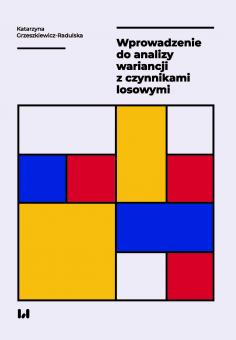-
2257
-
1082
-
1078
-
1037
-
989

Pliki do pobrania
Książka ta jest poświęcona problemom analizy wariancji (ANOVA) z czynnikami losowymi. Choć nie jest to problematyka nowa, jako że od lat jest obecna w piśmiennictwie statystycznym, to jednak jest względnie słabo wyeksponowana, szczególnie w wymiarze praktycznym. Z kolei w refleksji metodologicznej prowadzonej w naukach społecznych nad badaniami eksperymentalnymi jest ona praktycznie nieobecna. Celem książki jest wypełnienie tej luki i dostarczenie niezbędnej wiedzy na temat planowania eksperymentów z czynnikami losowymi, a także analizowania otrzymanych danych.
Pierwsza część książki poświęcona jest roli czynników losowych w planach eksperymentalnych. Autorka przywołuje wiele przykładów pytań problemowych pochodzących z nauk społecznych i uzasadnia, dlaczego rozwiązanie określonych problemów badawczych powinno nastąpić poprzez włączenie czynników losowych do planu eksperymentalnego. Omawia też niepoprawnie pod tym względem skonstruowane schematy badawcze, wskazując, że ich wady prowadzą do ustaleń o niskiej trafności, a nawet do ustaleń fałszywie pozytywnych.
W drugiej części książki omawiane są procedury analityczne dla modeli ANOVA uwzględniających czynniki stałe i czynniki losowe jednocześnie. To właśnie te modele będą w wielu przypadkach poprawną alternatywą dla tak powszechnie wykorzystywanych modeli uwzględniających jedynie czynniki stałe. Prezentowana wiedza pozwoli też badaczom dowiedzieć się, jak uogólniać wnioski na kilka populacji jednocześnie – nie tylko na populację jednostek, osób, czy respondentów, ale także na inne zbiorowości, którymi równolegle mogą być populacja reklam, słów, ankieterów, itd.
Podjęte w książce zagadnienie jest złożone, przede wszystkim od strony analitycznej. Zgodnie z tendencjami w literaturze światowej, autorka podejmuje szczególne starania, by przedstawiane treści wyłożyć w możliwie przystępny sposób.
adiunkt w Katedrze Metod i Technik Badań Społecznych Instytutu Socjologii Uniwersytetu Łódzkiego. Autorka książki Respondenci niedostępni w badaniach sondażowych (2009), a także współautorka publikacji Analizy weryfikacyjne - przeszłe i obecne doświadczenia badawcze (2017) oraz Analiza statystyczna z IBM SPSS Statistics (2020).
Aczel A.D. (2000), Statystyka w zarządzaniu, Wydawnictwo Naukowe PWN, Warszawa.
Ato M., Vallejo G., Palmer A. (2013), The two-way mixed models: A long and winding controversy, „Psicothema”, vol. 25, no. 1, s. 130–136.
Boik R.J. (2005), Randomization, [w:] B.S. Everitt, D.C. Howell (red.), Encyclopedia of Statistics in Behavioral Science, vol. 4, John Wiley & Sons, Chichester.
Bonge D.R., Schuldt W.J., Harper Y.Y. (1992), The experimenter-as-fixed-effect fallacy, „The Journal of Psychology”, vol. 126, no. 5, s. 477–486.
Brashers D.E., Jackson S. (1999), Changing conceptions of „message effects”. A 24-year overview, „Human Communication Research”, vol. 25, no. 4, s. 457–477.
Brennan R.L. (2001), Generalizability theory, Springer Verlag, Berlin-Heidelberg.
Brown H., Prescott R. (2015), Applied mixed models in medicine. Third edition, John Wiley & Sons, Chichester.
Brzeziński J.M. (2008), Badania eksperymentalne w psychologii i pedagogice, Wydawnictwo Naukowe Scholar, Warszawa.
Brzeziński J.M. (2009), Kiedy odwołując się do testów psychologicznych postępujemy nieetycznie? Analiza kontekstu, „Czasopismo Psychologiczne”, t. 15, nr 2, s. 321–332.
Clark H.H. (1973), The language-as-fixed-effect fallacy: A critique of language statistics in psychological research, „Journal of Verbal Learning and Verbal Behavior”, vol. 12, s. 335–359.
Clark H.H. (1976), Reply to Wike and Church, „Journal of Verbal Learning and Verbal Behavior”, vol. 15, s. 257–261.
Cohen J. (1976), Random means random, „Journal of Verbal Learning and Verbal Behavior”, vol. 15, s. 261–262.
Cohen J. (1988), Statistical power analysis for the behavioral sciences, Lawrence Erlbaum Associates, New York, NY.
Coleman E.B. (1964), Generalizing to language population, „Psychological Reports”, vol. 14, s. 219–226.
Coleman E.B. (1972–73), Generalization variable and restricted hypotheses, „Journal of Reading Behaviour”, vol. 5, no. 4, s. 226–236.
Coleman E.B. (1979), Generalization effects vs. random effects: Is σTL2 a source of type 1 or type 2 error?, „Journal of Verbal Learning and Verbal Behavior”, vol. 18, s. 243–256.
Converse J.M., Schuman H. (1974), Conversations at random: survey research as interviewers see it, John Wiley & Sons, New York, NY.
Cook T.D., Campbell D.T. (1979), Quasi-experimentation. Design & analysis issues for field settings, Houghton Mifflin Company, Boston, MA.
Cronbach L.J., Gleser G.C., Nanda H., Rajaratnam N. (1972), The dependability of behavioral measurements. Theory of generalizability for scores and profiles, Wiley, New York, NY.
Dijkstra W. (1983), How interviewer variance can bias the results of research on interview effect?, „Quality and Quantity”, vol. 17, s. 179–187.
Field A.P. (2005), Intraclass correlation, [w:] B.S. Everitt, D.C. Howell (red.), Encyclopedia of Statistics in Behavioral Science, vol. 2, John Wiley & Sons, Chichester.
Forster K.I., Dickinson R.G. (1976), More on the language-as-fixed-effect fallacy: Monte Carlo estimates or error rates for F1, F2, F’, and min F’, „Journal of Verbal Learning and Verbal Behavior”, vol. 15, s. 135–142.
Fowler F.J., Mangione T.W. (1990), Standardized survey interviewing. Minimizing interviewer-related error, Applied Social Research Methods Series, vol. 18, Sage Publications, Newbury Park.
Fuchs M. (2009), Gender-of-interviewer effects in a video-enhanced Web survey, „Social Psychology”, vol. 40, no. 1, s. 37–42.
Gamst G., Meyers L.S., Guarino A.J. (2008), Analysis of variance designs. A conceptual and computational approach with SPSS and SAS, Cambridge University Press, New York, NY.
Glass V.G., Hopkins K.D. (1996), Statistical methods in education and psychology. Third edition, Allyn and Bacon, Boston, MA.
Groves R.M. (1989), Survey errors and survey costs, John Wiley & Sons, New York, NY.
Hader R.J. (1973), An improper method of randomization in exeperimental design, „The American Statistician”, vol. 27, s. 82–84.
Hedges L.V., Hedberg E.C. (2007), Interclass correlation values for planning group randomized trials in education, „Educational Evaluation and Policy Analysis”, vol. 29, no. 1, s. 60–87.
Hopkins K.D. (1976), A simplified method for determining for expected mean sqaures and error terms in the analysis of variance, „The Journal of Experimental Education”, vol. 45, no. 2, s. 13–18.
Hopkins K.D. (1983), A strategy for analyzing ANOVA designs having one or more random factors, „Educational and Psycholigcal Measurement”, vol. 43, s. 107–113.
Howell D.C. (2007), Statistical methods for psychology. Seventh edition, Wadsworth Cengage Learning, Belmont, CA.
Jabkowski P. (2015), Reprezentatywność badań reprezentatywnych. Analiza wybranych problemów metodologicznych oraz praktycznych w paradygmacie całkowitego błędu pomiaru, Seria Socjologia, nr 77, Wydawnictwo Naukowe UAM, Poznań.
Jackson S. (1991), Meta-analysis for primary and secondary data analysis: the super-experiment metaphor, „Commmunication Monographs”, vol. 58, s. 449–462.
Jackson S. (1992), Message effects research. Principles of design and analysis, The Guilford Press, New York, NY.
Jackson S., Brashers D.E. (1994a), Random factors in ANOVA, Sage University Paper series on Quantitative Applications in the Social Sciences, series no. 07–098, Sage, Thousand Oaks, CA.
Jackson S., Brashers D.E. (1994b), M>1, Analysis of treatment x replication design, „Human Communication Research”, vol. 20, no. 3, s. 356–389.
Jackson S., Jacobs S. (1983), Generalizing about messages: suggestions for design and analysis of experiment, „Human Communication Research”, vol. 9, no. 2, s. 169–191.
Jackson S., Jacobs S. (1987), The search for systematic message effects. Contributions of meta-analysis and better design. Paper presented at the meeting of International Communication Association, Montreal.
Jackson S., Brashers D.E., Massey J. E. (1992), Statistical testing in treatment by replication design: three options reconsidered, „Communication Quarterly”, s. 211–227.
Jackson S., O’Keefe D.J., Brashers D.E. (1994), The messages replication factor: Methods tailored to messages as objects of study, „Journalism Quarterly”, vol. 71, no. 4, s. 984–996.
Jackson S., O’Keefe D.J., Jacobs S. (1988), The search for reliable generalizations about messages. A comparison of research strategies, „Human Communication Research”, vol. 15, no. 1, s. 127–142.
Jackson S., O’Keefe D.J., Jacobs S., Brashers D. (1989), Messages as replications: Toward a message-centered design starategy, „Communication Monographs”, vol. 56, no. 4, s. 364–384.
Judd C.M., McClelland G.H., Culhane S.E. (1995), Data analysis: continuing issues in the everyday analysis of psychological data, „Annual Review of Psychology”, vol. 46, s. 433–465.
Kahn R.L., Cannel C.F. (1957), The dynamics of interviewing, John Wiley & Sons, New York, NY.
Kay E.J., Richter M.L. (1977), The category-confound: A design error, „The Journal of Social Psychology”, vol. 103, s. 57–63.
Kenny D.A., Judd C.M. (1986), Consequances of violeting the independence assumption in analysis of variance, „Psychological Bulletin”, vol. 99, no. 3, s. 422–431.
Keppel G. (1976), Words as random variables, „Journal of Verbal Learning and Verbal Behavior”, vol. 15, s. 263–265.
Keppel G. (1982), Design and analysis: a researcher’s handbook. Second edition, Prentice Hall, Englewood Cliffs, NJ.
Keppel G., Wickens T.D. (2004), Design and analysis: a researcher’s handbook. Fourth edition, Pearson Prentice Hall, Upper Saddle River, NJ.
Kirk R.E. (1968), Experimental design: procedures for the behavioral sciences, Brooks/Cole Publishing Company, Belmont, CA.
Kirk R.E. (1996), Practical significance: a concept whose time has come, „Educational and Psycholigical Measurement”, vol. 56, no. 5, s. 746–759.
Kirk R.E. (2005), Effect size measures, [w:] B.S. Everitt, D.C. Howell (red.), Encyclopedia of Statistics in Behavioral Science, vol. 2, John Wiley & Sons, Chichester.
Koele P. (1982), Calculating power in analysis of variance, „Psychological Bullettin”, vol. 92, no. 2, s. 513–526.
Landis J.R., Sullivan J., Sheley (1973), Feminist attitudes as related to sex of the interviewer, „Pacific Sociological Review”, vol. 16, s. 305–314.
Lindman H.R. (1992), Analysis of variance in experimental design, Springer-Verlag, New York, NY.
Lisowska-Magdziarz M. (2004), Analiza zawartości mediów. Przewodnik dla studentów, seria wydawnicza: Zeszyty Wydziałowe, Zeszyt nr 1, Uniwersytet Jagielloński.
Malarska A. (2005), Statystyczna analiza danych wspomagana programem SPSS, SPSS Polska, Kraków.
Martindale C. (1978), The therapist-as-fixed-effect fallacy in psychotherapy research, „Journal of Consulting and Clinic Psychology”, vol. 46, no. 6, s. 1526–1530.
Maxwell S. E., Delaney H.D., Kelly K. (2018), Designing experiments and analyzing data. A model comparison perspective. Third edition, Routledge, Taylor & Francis, New York, NY.
Mcgraw K.O., Wong S.P. (1996), Forming inferences about intraclass correlation coefficients, „Psychological Methods”, vol. 1, no. 1, s. 30–46.
Pilkonis P.A., Imber S.D., Lewis P., Rubinsky P. (1984), A comparative outcome study of individual, group, and conjoint psychotherapy, „Psychotherapy”, vol. 41, s. 431–437.
Richter M.L., Seay M.B. (1987), ANOVA designs with subjects and stimuli as random effects: Applications to prototype effects on recognition memory, „Journal of Personality and Social Psychology”, vol. 53, no. 3, s. 470–480.
Rosenthal R., Rosnow R.L. (2009), Artifacts in behavioral research. Robert Rosenthal and Ralph L. Rosnow’s Classis Books, Oxford University Press, New York, NY.
Rozmus D. (2011), Analiza wariancji, [w]: E. Gatnar, M. Walesiak (red.), Analiza danych jakościowych i symbolicznych z wykorzystaniem programu R, Wydawnictwo C.H. Beck, Warszawa.
Rószkiewicz M., Perek-Białas J., Węziak-Białowolska D., Zięba-Pietrzak A. (2013), Projektowanie badań społeczno-ekonomicznych. Rekomendacje i praktyka badawcza, Wydawnictwo Naukowe PWN, Warszawa.
Rumenik D.K., Capasso D.R., Hendrick C. (1977), Experimenter sex effects in behavioral research, „Psychological Bulletin”, vol. 84, no. 5, s. 852–877.
Sahai H., Ageel M.I. (2000), The analysis of variance. Fixed, random and mixed models, Birkhäuser, Boston, MA.
Sahai H., Ojeda M.M. (2004), The analysis of variance for random models: theory, methods, applications and data analysis. Volume 1: Balance data, Springer Science+Business Media, New York, NY.
Santa J.L., Miller J.L., Shaw M.L. (1979), Using quasi F to prevent alpha inflation due to stimulus variation, „ Psychological Bulletin”, vol. 86, no. 1, s. 37–46.
Satterthwaite F.E. (1946), An approximate distribution of estimates of variance components, „Biometrics Bulletin”, vol. 2, s. 110–114.
Scheffé H.A. (1959), The analysis of variance, John Wiley & Sons, New York, NY.
Schwarz C.J. (1993), The mixed-model ANOVA: The truth, the computer packages, the book. Part I: Balanced data, „The American Statistican”, vol. 47, no. 1, s. 48–59.
Shadish W.R., Cook T.D., Campbell D.T. (2002), Experimental and quasi-experimental designs for generalized causal inference, Houghton Mifflin Company, Boston, MA.
Shavelson R.J., Webb N.M. (1991), Generalizability theory. A primer, Sage, Newbury Park.
Sitek W. (1976), Ankieter humanista i ankieter technik. Teoretyczne i praktyczne aspekty typologicznej selekcji ankieterów, [w]: Z. Gostkowski (red.), Z metodologii i metodyki socjologicznych badań terenowych: zeszyt 4, Warszawa, IFiS PAN, s. 63–113.
Smith P.T. (2005), Random effects and fixed effects fallacy, [w:] B.S. Everitt, D.C. Howell (red.), Encyclopedia of Statistics in Behavioral Science, vol. 4, John Wiley & Sons, Chichester.
Stanisz A. (2007), Przystępny kurs statystyki z zastosowaniem STATISTICA PL na przykładach z medycyny. Tom 2. Modele liniowe i nieliniowe, Stat-Soft Polska, Kraków.
Sułek A. (1979), Eksperyment w badaniach społecznych, PWN, Warszawa.
Sułek A. (2002), Ogród metodologii socjologicznej, Wydawnictwo Naukowe Scholar, Warszawa.
Sztabiński P.B. (1997), Ankieterzy i ich respondenci. Od kogo zależą wyniki badań ankietowych, IFiS PAN, Warszawa.
Szymczak W. (2018), Podstawy statystyki dla psychologów. Podręcznik akademicki, Difin, Warszawa.
Tchach C., Berger V.W. (2005), Simple random assignment, [w:] B.S. Everitt, D.C. Howell (red.), Encyclopedia of Statistics in Behavioral Science, vol. 4, John Wiley & Sons, Chichester.
Tversky A., Kahneman D. (1971), Belief in the law of small numbers, „Psychological Bulletin”, vol. 76, no. 2.
Vaughan G.M., Corballis M.C. (1969), Beyond tests of significance: Estimating strength of effects in selected ANOVA designs, „Psychological Bulletin”, vol. 72, no. 3, s. 204–213.
Vogt W.P., Johnson R.B. (2016), The Sage dictionary of statistics & methodology. A nontechnical guide for the social sciences. Fifth edition, Sage, Los Angeles, CA.
Wells G.L., Windschitl P.D. (1999), Stimulus sampling and social psychological experimentation, „Personality and Social Psychology Bulletin”, vol. 25, s. 1115–1125.
West S.G. (2006), Poza eksperyment laboratoryjny – plany eksperymentalne oraz quasi-eksperymentalne w otoczeniu naturalnym, [w]: J. Brzeziński (red.), Metodologia badań psychologicznych. Wybór tekstów, Wydawnictwo Naukowe PWN, Warszawa.
Wickens T.D., Keppel G. (1983), One the choice of design and of test statistic in the analysis of experiments with sampled materials, „Journal of Verbal Learning and Verbal Behavior”, vol. 22, s. 296–309.
Wike E.L., Church J.D. (1976), Comments on Clark’s “The Language-as-fixedeffect fallacy” , „Journal of Verbal Learning and Verbal Behavior”, vol. 15, s. 249–255.
Wiktorowicz J., Grzelak M.M., Grzeszkiewicz-Radulska K. (2020), Analiza statystyczna z IBM SPSS Statistics, Wydawnictwo Uniwersytetu Łódzkiego, Łódź.
Winer B.J. (1971), Statistical principles in experimental design. Second Edition, McGraw-Hill, New York, NY.
Winer B.J., Brown D.R., Michels K.M. (1991), Statistical principles in experimental design, McGraw-Hill, New York, NY.

Utwór dostępny jest na licencji Creative Commons Uznanie autorstwa – Użycie niekomercyjne – Bez utworów zależnych 4.0 Międzynarodowe.
| Mapa strony | Księgarnia | Social Media |
42 635 55 77 42 235 01 62 ksiegarnia@uni.lodz.pl Biuro: 42 235 01 65 42 635 55 80 agnieszka.janicka@uni.lodz.pl Polityka prywatności i cookies © 2024 Uniwersytet Łódzki |
    |


